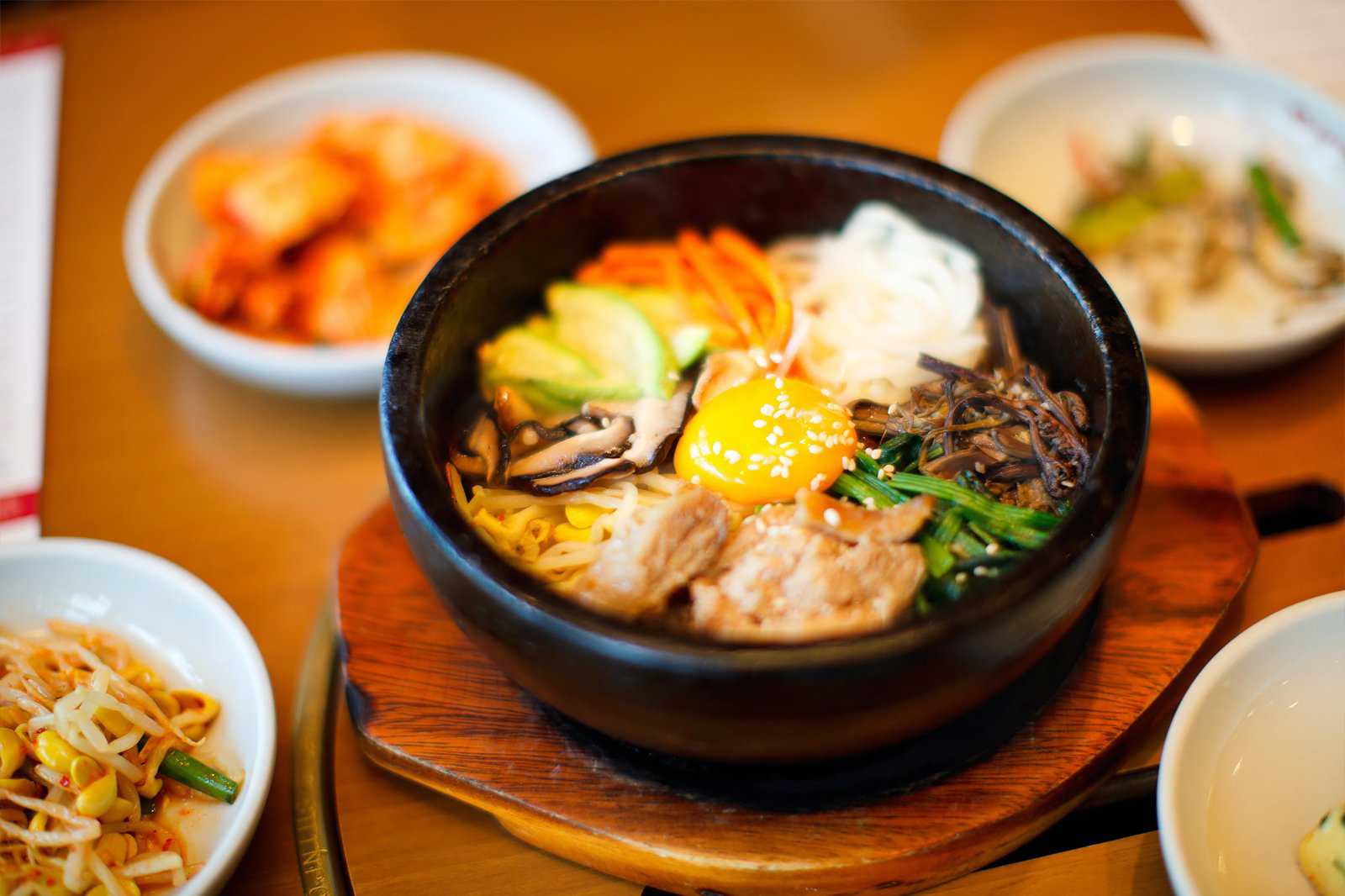Great South Korean dishes can be found virtually everywhere in this vibrant country, from street vendors along narrow alleyways to classy restaurants within 5-star hotels. Many of these delicacies have existed for more 2,000 years, and were only consumed by Korean royal families.
Today, Korean food has become so popular that locals and tourists alike describe them as savoury, spicy, hearty and nutritious delights that can be enjoyed at any time of the day. We’ve compiled a list of top foods you must sample during your stay in South Korea
- 1
Kimchi
Signature dish more than 2,000 years old

- Ételek
This signature Korean dish has been around for more than 2,000 years, dating back to the Shilla Dynasty. Kimchi consists of Korean cabbage, radish, pumpkin, onion, ginger and scallion with chilli powder, crushed garlic and salted seafood, which is then left to ferment.
With more than 200 variations available in Seoul alone, this traditional cuisine is eaten on its own or with white rice, and added into porridges, soups and rice cakes. Kimchi is also the basis for many derivative dishes such as a kimchi stew named kimchi jjigae, a kimchi pancake named kimchijeon and kimchi fried rice.
- 2
Bibimbap
A hearty Korean staple

- Ételek
Another must-try during your visit to South Korea is bibimbap, a filling and nutritious dish that’s widely available in restaurants, food courts and street markets. Depending on region and ingredients used, bibimbap can be served as a meat-based or vegetarian dish.
The most common bibimbap consists of warm rice topped with mixed vegetables, beef or chicken, and raw egg, as well as soy sauce and a dollop of chilli pepper paste for seasoning. Ideal for seafood lovers, there’s a variation of this Korean mixed rice dish called hoedeopbap, which replaces meat with raw seafood such as salmon, tuna or octopus.
- 3
Tteokbokki

- Ételek
Tteokbokki is a traditional Korean street food that’s made with thick slices of a type of boiled rice cake called garaetteok, alongside fish cake, onions, diced garlic, salt, sugar and assorted vegetables that are stir-fried in sweet, red chilli sauce. Distinguished by its bright red-orange colour, this popular snack is usually sold by street vendors and independent snack bars.
Tteokbokki has become such a beloved Korean dish that many have created variations over the years. Why not try them made with a gooey cheese or with a black bean sauce? You won’t have to miss out if you’ve got a milder palate, as cream can be added to create rose tteokbokki.
- 4
Bulgogi
Smoky beef for tasty lettuce wraps

- Ételek
Bulgogi consists of thin slices of marinated beef sirloin that are cooked alongside sliced onions, green peppers and garlic using a charcoal burner, resulting in a distinctive smoky flavour. Prior to cooking, the meat is marinated between 2 and 4 hours in a mixture of soy sauce, sesame oil, black pepper, garlic, onions, ginger and sugar to enhance its flavour and tenderness.
This dish is usually served with a side of leafy vegetables like lettuce and spinach, which is used to wrap a slice of cooked meat, often along with ssamjang, which is a spicy soybean paste, and kimchi. It proved so popular, it’s now enjoyed worldwide.
A kép készítője: stu_spivack (CC BY-SA 2.0) módosítva
- 5
Jjigae
A stew with diversity

- Ételek
There are many different varieties of jjigae, but this Korean stew usually contains meat, seafood or vegetables in a broth seasoned with a hot pepper paste called gochujang, a fermented miso called gaenjang and soybean paste. Alternatively, a salted, fermented shrimp called saeujeot may be used. Usually served as a palate cleanser between heavier dishes, jjigae has a similar consistency to a western stew.
One of the most popular jjigae dishes in Seoul in particular is budae jjigae, or army stew, which incorporates bacon, sausages and Spam meat, as well as ramyeon noodles and rice cakes mixed with gochujang paste for a spicy flavour.
- 6
Jajangmyeon
A delicious noodle dish combining Korean and Chinese flavours

- Ételek
A Korean-Chinese fusion dish, jajangmyeon uses thick, handmade wheat noodles topped with raw cucumber slices and a mixture of salty black soybean paste, diced pork and vegetables. Moderately priced, this hearty noodle dish is great when you need a quick, hearty meal that doesn't empty the wallet during your trip to South Korea.
It's also usually eaten by singles on Black Day, which takes places each year on April 14th. Those who do not receive gifts during Valentine’s Day wear black attire and gather to consume black-coloured food such as jajangmyeon.
A kép készítője: egg (Hong, Yun Seon) (CC BY 2.0) módosítva
- 7
Samgyeopsal
Perfect for friendly gatherings after busy days

- Ételek
Samgyeopsal is another staple Korean dish that requires few culinary skills, where chunky slices of pork belly are cooked on a grill at the diners’ table. It's then wrapped in lettuce or sesame leaf with dipping sauces and accompaniments such as button mushrooms, green chilli peppers, green onions, raw onions, garlic and, of course, kimchi.
A popular dish among young working adults, samgyeopsal is usually paired with a shot or 2 of soju alcohol. It’s the perfect meal to enjoy over a gathering with friends whilst you’re in South Korea.
- 8
Korean fried chicken

- Ételek
Korean fried chicken takes on the quintessential American fast food with its own unique flair. Unlike its American counterparts, the chicken is coated with a sweet and spicy sauce before double frying it in vegetable oil. Some restaurants even add green pepper inside the batter for a spicier kick.
As a result, the meat is very juicy on the inside, while the lightly battered skin is crunchy with very little grease. It is a popular late-night snack that’s typically served with beer.
A kép készítője: istolethetv (CC BY 2.0) módosítva
- 9
Bibim nengmyun

- Ételek
Bibim nengmyun is typically served in a stainless-steel bowl with a cold broth, julienned cucumbers, Korean pear slices, boiled egg and slices of cold, boiled beef. The long and thin noodles are made from flour and buckwheat or sweet potatoes, though seaweed and green tea are also used for other, more unusual, variations.
Symbolising longevity of life and good health, the noodles are traditionally served without cutting, but diners can request for waiters to cut the noodles according to their preference.
A kép készítője: Jinho Jung (CC BY 2.0) módosítva
- 10
Samgyetang
An unusually refreshing summer meal

- Ételek
Koreans believe that the body’s energy must be replenished during summer, so it’s a common practice for them to consume a piping hot bowl of samgyetang, which translates to chicken ginseng soup, between the months of June and early September.
This nourishing soup consists of a small spring chicken stuffed with chestnuts, garlic, dried jujubes, ginseng, glutinous rice and gingko nuts. The ingredients are then slow-cooked until the meat is very tender and the thick broth permeates a slightly bitter yet fragrant taste.



















